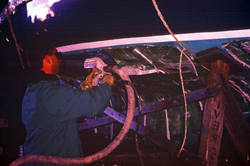New York Sea Grant's
Marina Pollution Prevention Web Site
Section 2: Painting
& Fiberglass Repair
- Paint Stripping
Potential Environmental Impacts:
Many paint strippers are solvent-based, and contain chemicals
that are dangerous to humans. Some are flammable, and most can
cause water and air pollution if not handled properly. Toxic chemicals
in paint strippers may include methylene chloride (also called
dichloromethane, or DCM), methyl ethyl ketone (or 2-Butanone),
acetone, toluene, methanol, N-methylpyrrolidone (NMP), or xylene.
There are some less environmentally damaging and less hazardous
paint strippers available on the market.
Best
Management Practices:
Consider alternatives to chemical paint stripping depending on
the characteristics of the surface being stripped, the type of
paint being removed, and the volume and type of waste produced.
Alternatives include scraping, sanding, and/or abrasive blasting.
Use a heat gun to remove paint and varnish where appropriate.
See the "Scraping and Sanding" (click
here) and "Abrasive Blasting"
(click
here) fact sheets for more information.
If paint strippers
must be used, use soy-based or water-based products, which are
less hazardous. For more information on alternative paint strippers,
click
here.
Use only the
minimum amount of paint stripper needed for a job.
Prevent evaporation
by using tight fitting lids or stoppers. Reducing evaporation
protects air quality, saves product and money.
Reduce the
chance of spills during transport by storing unused paint stripper
where it's used most in the shop. Place the product on an impervious
base.
Encourage
careful use by informing all workers and operators of the hazardous
nature of solvents and the purchasing and recycling costs.
Train employees
to use less paint stripper, to properly store  new
and used paint strippers, to use wise clean-up procedures and
prevent leaks and spills. Consider using a pressure wash vacuum
system to collect and contain the stripper and paint from the
hull, click
here.
new
and used paint strippers, to use wise clean-up procedures and
prevent leaks and spills. Consider using a pressure wash vacuum
system to collect and contain the stripper and paint from the
hull, click
here.
Regulatory
Issues:
You must determine if used paint stripper is hazardous by having
the materials tested or by utilizing reliable "knowledge
of process" information for the waste (if available) [40
CFR 262.11, click
here].
Such information could include testing by haulers, or studies
by industry trade groups. For more information on New York
hazardous waste testing requirements, click
here. If they are hazardous, they must be managed
as a hazardous waste. For more information on New York's Hazardous
Waste Regulations and storage requirements, click
here. If there is a stormwater discharge from your
facility and materials associated with paint stripping may come
into contact with precipitation, you may have to register for
a General Permit for the Discharge of Storm Water Associated with
Industrial Activity ("Storm Water General Permit").
For more information on stormwater permitting in New York,
click
here.

